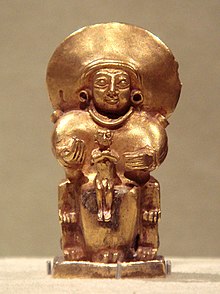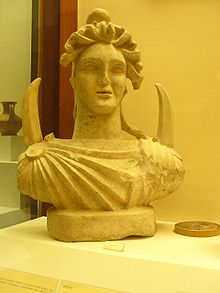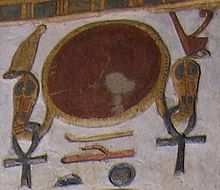This article should specify the language of its non-English content, using {{
lang}}, {{
transliteration}} for transliterated languages, and {{
IPA}} for phonetic transcriptions, with an appropriate
ISO 639 code. Wikipedia's
multilingual support templates may also be used. (January 2024) |
| *Seh₂ul | |
|---|---|
Sun Goddess | |
 Possible depiction of the
Hittite Sun goddess holding a child in her arms from between 1400 and 1200 BC. | |
| Abode | Sky |
| Planet | Sun |
| Symbol | Chariot, solar disk |
| Day | Sunday |
| Equivalents | |
| Greek equivalent | Helios |
| Roman equivalent | Sol |
| Etruscan equivalent | Usil |
| Hinduism equivalent | Surya |
| Hittite equivalent | UTU-liya |
| Lithuanian equivalent | Saulė |
| Zoroastrian equivalent | Hvare-khshaeta |
| Germanic equivalent | Sowilō |
| Celtic equivalent | Sulis |
| *Meh₁not | |
|---|---|
Moon God | |
 Bust of
Men a deity considered descended from *Meh₁not | |
| Abode | Sky |
| Planet | Moon |
| Day | Monday |
| Equivalents | |
| Greek equivalent | Mene ( Selene) |
| Roman equivalent | Luna |
| Slavic equivalent | Myesyats |
| Hittite equivalent | Kašku |
| Phrygian equivalent | Men |
| Zoroastrian equivalent | Mah |
| Latvian equivalent | Mēness |
| Germanic equivalent | Máni |
*Seh₂ul and *Meh₁not are the reconstructed Proto-Indo-European goddess of the Sun and god of the Moon. *Seh₂ul is reconstructed based on the solar deities of the attested Indo-European mythologies, although its gender (male or female) is disputed, since there are deities of both genders. [1] Likewise, *Meh₁not- is reconstructed based on the lunar deities of the daughter languages, but they differ in regards to their gender.
The daily course of *Seh₂ul across the sky on a horse-driven chariot is a common motif among Indo-European myths. [note 1] While it is probably inherited, the motif certainly appeared after the introduction of the wheel in the Pontic–Caspian steppe about 3500 BC, and is therefore a late addition to Proto-Indo-European culture. [3]
The Sun deity
*Seh₂ul is reconstructed based on the Greek god Helios, the Greek mythological figure Helen of Troy, [4] [5] the Roman god Sol, the Celtic goddess Sulis / Sul/Suil, the North Germanic goddess Sól, the Continental Germanic goddess *Sowilō, the Hittite goddess "UTU-liya", [6] the Zoroastrian Hvare-khshaeta [6] and the Vedic god Surya. [7]
In the mythologies of the daughter languages (namely, Baltic, Greek and Old Indic), the sun deity crosses the sky in a horse-driven chariot or wagon. However, Mallory and Adams caution that the motif is not exclusively Indo-European, and mention evidence of its presence in Mesopotamia. [8]
A character related to the Sun deity is the 'Sun-maiden'. [9] Mallory and Adams cite as examples 'Saules meita', the daughter of Saulé in Baltic tradition, and Sūryā, daughter to Indic Sun god Sūrya. [10] However, both scholars, as well as Martin L. West, also posit Helen of Troy, from Greek mythology, was another example of the 'Sun-maiden'. [7] [11]
The Moon deity
*Meh₁not- is reconstructed based on the Norse god Máni, the Slavic god Myesyats, [note 2] [6] and the Lithuanian god * Meno, or Mėnuo (Mėnulis). [14] Remnants of the lunar deity may exist in Latvian moon god Mēness, [15] Anatolian (Phrygian) deity Men; [16] [15] Mene, another name for Selene, and in Zoroastrian lunar deity Mah (Måŋha). [17] [18] [19]
Alternative myth

Although the sun was personified as an independent, female deity, [20] the Proto-Indo-Europeans also visualized the sun as the "lamp of Dyēws" or the "eye of Dyēws", as seen in various reflexes: "the god's lamp" in Medes by Euripides, "heaven's candle" in Beowulf, or "the land of Hatti's torch", as the Sun-goddess of Arinna is called in a Hittite prayer; [21] and Helios as the eye of Zeus, [22] [23] Hvare-khshaeta as the eye of Ahura Mazda, and the sun as "God's eye" in Romanian folklore. [24] The names of Celtic sun goddesses like Sulis and Grian may also allude to this association: the words for "eye" and "sun" are switched in these languages, hence the name of the goddesses. [25]
Egyptian mythology is unrelated to Indo-European mythology so there is unlikely any historical link, but the metaphor of Eye of Ra was used in it too.
See also
Notes
References
- ^ West 2007, p. 195-196.
- ^ Agostini, Domenico; Thrope, Samuel. The bundahišn: The Zoroastrian Book of Creation. New York: Oxford University Press, 2020. p. 19. ISBN 9780190879044
- ^ Fortson 2004, p. 23.
- ^ O'Brien, Steven. "Dioscuric Elements in Celtic and Germanic Mythology". In: Journal of Indo-European Studies 10:1–2 (Spring–Summer, 1982), pp. 117–136.
- ^ Meagher, Robert E. (2002). The Meaning of Helen: In Search of an Ancient Icon. Bolchazy-Carducci Publishers. pp. 46ff. ISBN 978-0-86516-510-6.
- ^ a b c Gamkrelidze & Ivanov 1995, p. 760.
- ^ a b Mallory & Adams 1997, p. 232.
- ^ Mallory & Adams 1997, p. 278.
- ^ West 2007, p. 227-232.
- ^ Mallory & Adams 1997, p. 556.
- ^ West 2007, p. 230-231.
- ^ Jones, Prudence; Pennick, Nigel (1995). A History of Pagan Europe. Routledge. p. 186. ISBN 978-1-136-14172-0.
- ^ Dixon-Kennedy, Mike (1998). Encyclopedia of Russian and Slavic myth and legend. p. 188. ABC-CLIO. ISBN 978-1-57607-130-4
- ^ Mallory & Adams 1997, p. 385.
- ^ a b Lurker, Manfred. The Routledge Dictionary Of Gods Goddesses Devils And Demons. Routledge. 2004. p. 123. ISBN 978-04-15340-18-2
- ^ Keneryi, Karl (1951). The Gods of the Greeks. Thames & Hudson. pp. 196–197; Hammond, N.G.L. and Howard Hayes Scullard (editors), The Oxford Classical Dictionary. Second edition. Oxford University Press, 1992. "SELENE" entry. pp. 970–971. ISBN 0-19-869117-3
- ^ Beekes, Robert (1982). "Gav. må, the Pie word for 'moon, month', and the perfect participle" (PDF). Journal of Indo-European Studies. 10: 53–64.
- ^ York, Michael (August 1993). "Toward a Proto-Indo-European vocabulary of the sacred". WORD. 44 (2): 235–254. doi: 10.1080/00437956.1993.11435902.
- ^ Lurker, Manfred. The Routledge Dictionary Of Gods Goddesses Devils And Demons. Routledge. 2004. p. 115. ISBN 978-04-15340-18-2
- ^ Mallory & Adams 2006, p. 427.
- ^ West 2007, p. 195.
- ^ Sick, David (2004). "Mit(h)ra(s) and the Myths of the Sun". Numen. 51 (4): 432–467. doi: 10.1163/1568527042500140.
- ^ Bortolani, Ljuba Merlina (2016). Magical Hymns from Roman Egypt: A Study of Greek and Egyptian Traditions of Divinity. Cambridge University Press. ISBN 9781316673270.
- ^ Ionescu, Doina; Dumitrache, Cristiana (2012). "The Sun Worship with the Romanians" (PDF). Romanian Astronomical Journal. 22 (2): 155–166. Bibcode: 2012RoAJ...22..155I.
- ^ MacKillop, James. (1998). Dictionary of Celtic Mythology. Oxford: Oxford University Press ISBN 0-19-280120-1 pp.10, 16, 128
Sources
- Fortson, Benjamin W. (2004). Indo-European Language and Culture. Blackwell Publishing. ISBN 1-4051-0316-7.
- Gamkrelidze, Thomas V.; Ivanov, Vjaceslav V. (1995). Winter, Werner (ed.). Indo-European and the Indo-Europeans: A Reconstruction and Historical Analysis of a Proto-Language and a Proto-Culture. Trends in Linguistics: Studies and Monographs 80. Berlin: M. De Gruyter.
- Mallory, James P.; Adams, Douglas Q. (1997). Encyclopedia of Indo-European Culture. London: Routledge. ISBN 978-1-884964-98-5.
- Mallory, James P.; Adams, Douglas Q. (2006). The Oxford Introduction to Proto-Indo-European and the Proto-Indo-European World. Oxford, England: Oxford University Press. ISBN 978-0-19-929668-2.
- West, Martin L. (2007). Indo-European Poetry and Myth. Oxford, England: Oxford University Press. ISBN 978-0-19-928075-9.